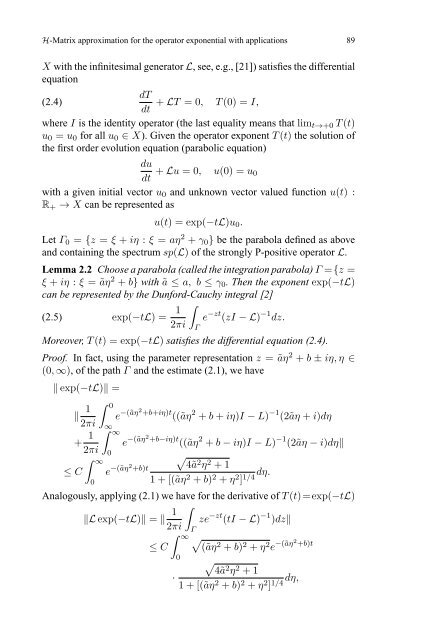H-Matrix approximation for the operator exponential with applications
H-Matrix approximation for the operator exponential with applications
H-Matrix approximation for the operator exponential with applications
You also want an ePaper? Increase the reach of your titles
YUMPU automatically turns print PDFs into web optimized ePapers that Google loves.
H-<strong>Matrix</strong> <strong>approximation</strong> <strong>for</strong> <strong>the</strong> <strong>operator</strong> <strong>exponential</strong> <strong>with</strong> <strong>applications</strong> 89<br />
X <strong>with</strong><strong>the</strong> infinitesimal generator L, see, e.g., [21]) satisfies <strong>the</strong> differential<br />
equation<br />
dT<br />
(2.4)<br />
+ LT =0, T(0) = I,<br />
dt<br />
where I is <strong>the</strong> identity <strong>operator</strong> (<strong>the</strong> last equality means that lim t→+0 T (t)<br />
u 0 = u 0 <strong>for</strong> all u 0 ∈ X). Given <strong>the</strong> <strong>operator</strong> exponent T (t) <strong>the</strong> solution of<br />
<strong>the</strong> first order evolution equation (parabolic equation)<br />
du<br />
dt + Lu =0, u(0) = u 0<br />
<strong>with</strong>a given initial vector u 0 and unknown vector valued function u(t) :<br />
R + → X can be represented as<br />
u(t) = exp(−tL)u 0 .<br />
Let Γ 0 = {z = ξ + iη : ξ = aη 2 + γ 0 } be <strong>the</strong> parabola defined as above<br />
and containing <strong>the</strong> spectrum sp(L) of <strong>the</strong> strongly P-positive <strong>operator</strong> L.<br />
Lemma 2.2 Choose a parabola (called <strong>the</strong> integration parabola) Γ ={z =<br />
ξ + iη : ξ =ãη 2 + b} <strong>with</strong> ã ≤ a, b ≤ γ 0 . Then <strong>the</strong> exponent exp(−tL)<br />
can be represented by <strong>the</strong> Dun<strong>for</strong>d-Cauchy integral [2]<br />
(2.5) exp(−tL) = 1 ∫<br />
e −zt (zI −L) −1 dz.<br />
2πi Γ<br />
Moreover, T (t) = exp(−tL) satisfies <strong>the</strong> differential equation (2.4).<br />
Proof. In fact, using <strong>the</strong> parameter representation z =ãη 2 + b ± iη, η ∈<br />
(0, ∞), of <strong>the</strong> path Γ and <strong>the</strong> estimate (2.1), we have<br />
‖ exp(−tL)‖ =<br />
‖ 1<br />
2πi<br />
+ 1<br />
2πi<br />
≤ C<br />
∫ 0<br />
∫∞<br />
∞<br />
e −(ãη2 +b+iη)t ((ãη 2 + b + iη)I − L) −1 (2ãη + i)dη<br />
0<br />
∫ ∞<br />
e −(ãη2 +b)t<br />
0<br />
e −(ãη2 +b−iη)t ((ãη 2 + b − iη)I − L) −1 (2ãη − i)dη‖<br />
√<br />
4ã 2 η 2 +1<br />
1+[(ãη 2 + b) 2 + η 2 dη.<br />
] 1/4<br />
Analogously, applying (2.1) we have <strong>for</strong> <strong>the</strong> derivative of T (t)=exp(−tL)<br />
‖L exp(−tL)‖ = ‖ 1 ∫<br />
ze −zt (tI −L) −1 )dz‖<br />
2πi Γ<br />
∫ ∞ √<br />
≤ C (ãη 2 + b) 2 + η 2 e −(ãη2 +b)t<br />
0<br />
√<br />
4ã<br />
·<br />
2 η 2 +1<br />
1+[(ãη 2 + b) 2 + η 2 dη,<br />
] 1/4
















